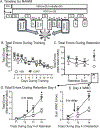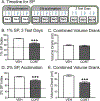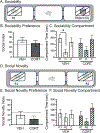Corticosterone disrupts spatial working memory during retention testing when highly taxed, which positively correlates with depressive-like behavior in middle-aged, ovariectomized female rats
- PMID: 39003890
- PMCID: PMC11330725
- DOI: 10.1016/j.yhbeh.2024.105600
Corticosterone disrupts spatial working memory during retention testing when highly taxed, which positively correlates with depressive-like behavior in middle-aged, ovariectomized female rats
Abstract
Major Depressive Disorder affects 8.4 % of the U.S. population, particularly women during perimenopause. This study implemented a chronic corticosterone manipulation (CORT, a major rodent stress hormone) using middle-aged, ovariectomized female rats to investigate depressive-like behavior, anxiety-like symptoms, and cognitive ability. CORT (400 μg/ml, in drinking water) was administered for four weeks before behavioral testing began and continued throughout all behavioral assessments. Compared to vehicle-treated rats, CORT significantly intensified depressive-like behaviors: CORT decreased sucrose preference, enhanced immobility on the forced swim test, and decreased sociability on a choice task between a novel conspecific female rat and an inanimate object. Moreover, CORT enhanced anxiety-like behavior on a marble bury task by reducing time investigating tabasco-topped marbles. No effects were observed on novelty suppressed feeding or the elevated plus maze. For spatial working memory using an 8-arm radial arm maze, CORT did not alter acquisition but disrupted performance during retention. CORT enhanced the errors committed during the highest working memory load following a delay and during the last trial requiring the most items to remember; this cognitive metric positively correlated with a composite depressive-like score to reveal that as depressive-like symptoms increased, cognitive performance worsened. This protocol allowed for the inclusion of multiple behavioral assessments without stopping the CORT treatment needed to produce a MDD phenotype and to assess a battery of behaviors. Moreover, that when middle-age was targeted, chronic CORT produced a depressive-like phenotype in ovariectomized females, who also comorbidly expressed aspects of anxiety and cognitive dysfunction.
Keywords: Aging; Anxiety; Chronic stress; Cognition; Corticosterone; Depression; Estrogen; Memory.
Copyright © 2024 Elsevier Inc. All rights reserved.
Conflict of interest statement
Declaration of competing interest None.
Figures







Similar articles
-
Chronic 17β-estradiol treatment improves negative valence, anhedonic profile, and social interactions in ovariectomized, middle-aged female rats.Front Behav Neurosci. 2025 Jul 2;19:1553501. doi: 10.3389/fnbeh.2025.1553501. eCollection 2025. Front Behav Neurosci. 2025. PMID: 40672384 Free PMC article.
-
The Black Book of Psychotropic Dosing and Monitoring.Psychopharmacol Bull. 2024 Jul 8;54(3):8-59. Psychopharmacol Bull. 2024. PMID: 38993656 Free PMC article. Review.
-
Sexual Harassment and Prevention Training.2024 Mar 29. In: StatPearls [Internet]. Treasure Island (FL): StatPearls Publishing; 2025 Jan–. 2024 Mar 29. In: StatPearls [Internet]. Treasure Island (FL): StatPearls Publishing; 2025 Jan–. PMID: 36508513 Free Books & Documents.
-
Short-Term Memory Impairment.2024 Jun 8. In: StatPearls [Internet]. Treasure Island (FL): StatPearls Publishing; 2025 Jan–. 2024 Jun 8. In: StatPearls [Internet]. Treasure Island (FL): StatPearls Publishing; 2025 Jan–. PMID: 31424720 Free Books & Documents.
-
Breastfeeding interventions for preventing postpartum depression.Cochrane Database Syst Rev. 2025 Feb 18;2(2):CD014833. doi: 10.1002/14651858.CD014833.pub2. Cochrane Database Syst Rev. 2025. PMID: 39963955
Cited by
-
Prenatal maternal life adversity impacts on learning and memory in offspring: implication to transgenerational epigenetic inheritance.Front Neurosci. 2025 Feb 13;19:1518046. doi: 10.3389/fnins.2025.1518046. eCollection 2025. Front Neurosci. 2025. PMID: 40018363 Free PMC article.
-
Chronic 17β-estradiol treatment improves negative valence, anhedonic profile, and social interactions in ovariectomized, middle-aged female rats.Front Behav Neurosci. 2025 Jul 2;19:1553501. doi: 10.3389/fnbeh.2025.1553501. eCollection 2025. Front Behav Neurosci. 2025. PMID: 40672384 Free PMC article.
-
Sex differences in anxiety and depression: insights from adult rodent models of chronic stress and neural plasticity.Front Behav Neurosci. 2025 May 14;19:1591973. doi: 10.3389/fnbeh.2025.1591973. eCollection 2025. Front Behav Neurosci. 2025. PMID: 40438297 Free PMC article. Review.
References
-
- American Psychiatric Association, 2013. DSM-V, American Journal of Psychiatry. 10.1176/appi.books.9780890425596.744053. - DOI
-
- Anxiety and Depression Association of America, 2017. Facts & Statistics | Anxiety and Depression Association of America, ADAA [WWW Document]. Anxiety Depress. Assoc. Am.
Publication types
MeSH terms
Substances
Grants and funding
LinkOut - more resources
Full Text Sources
Medical

